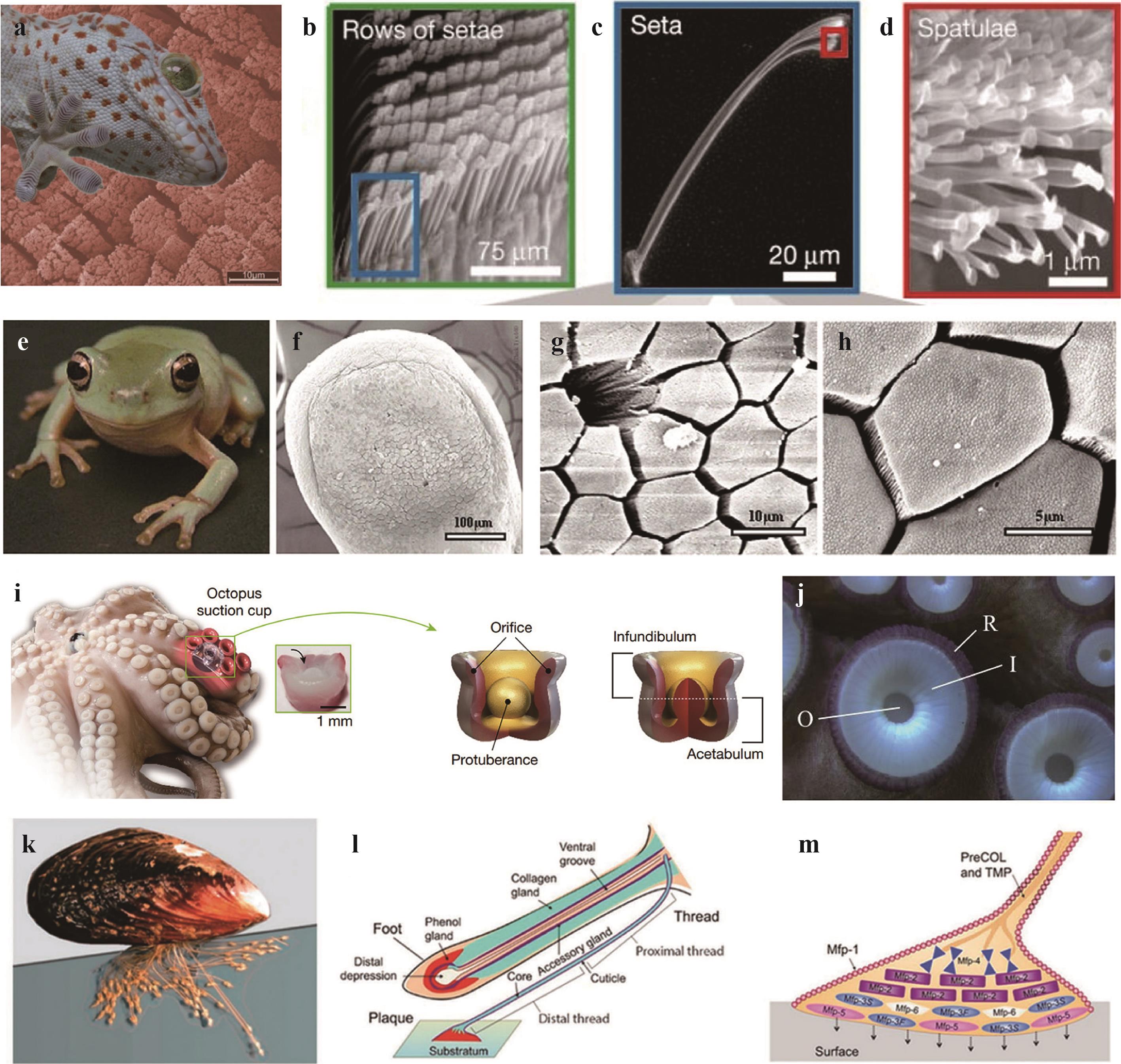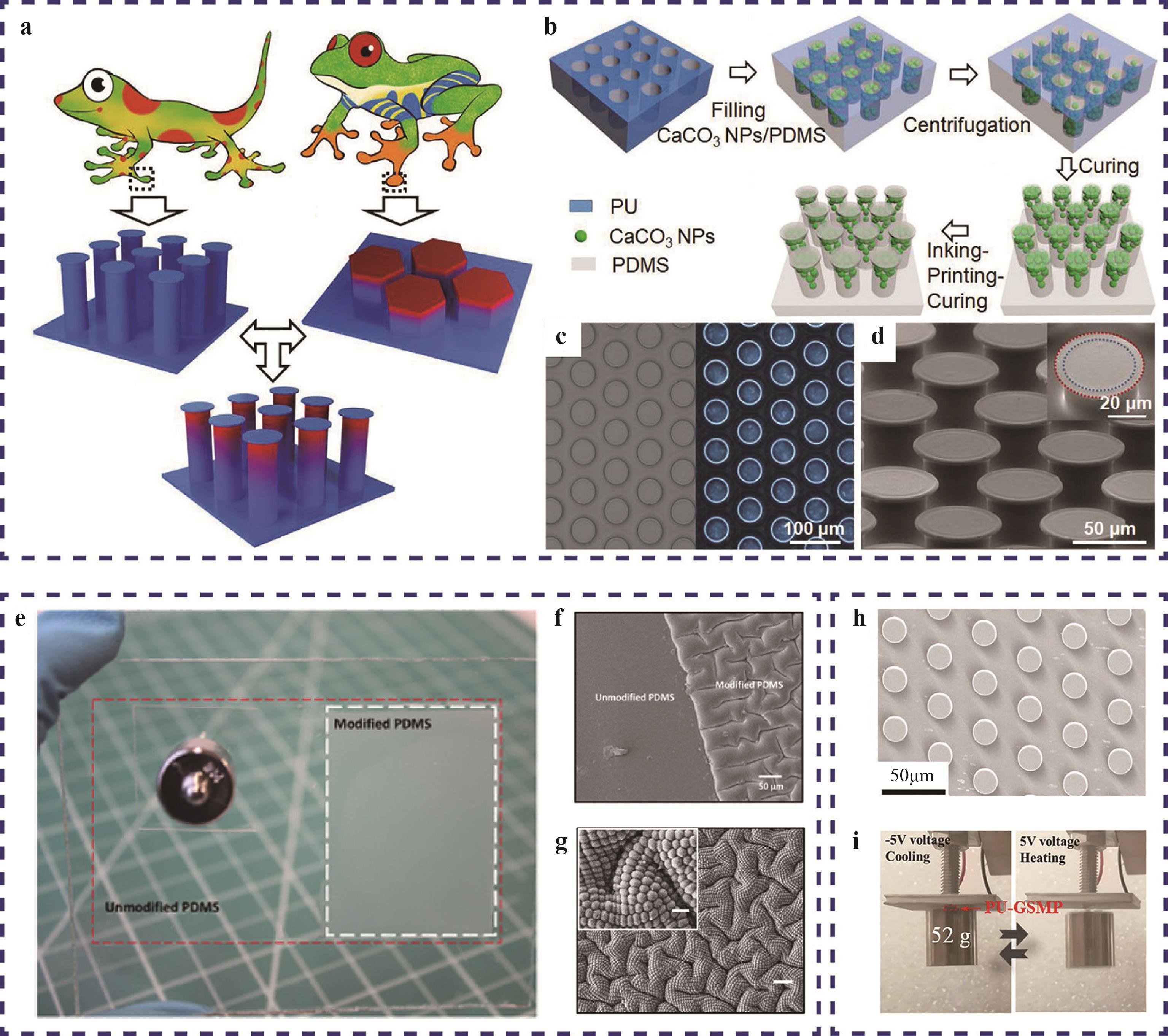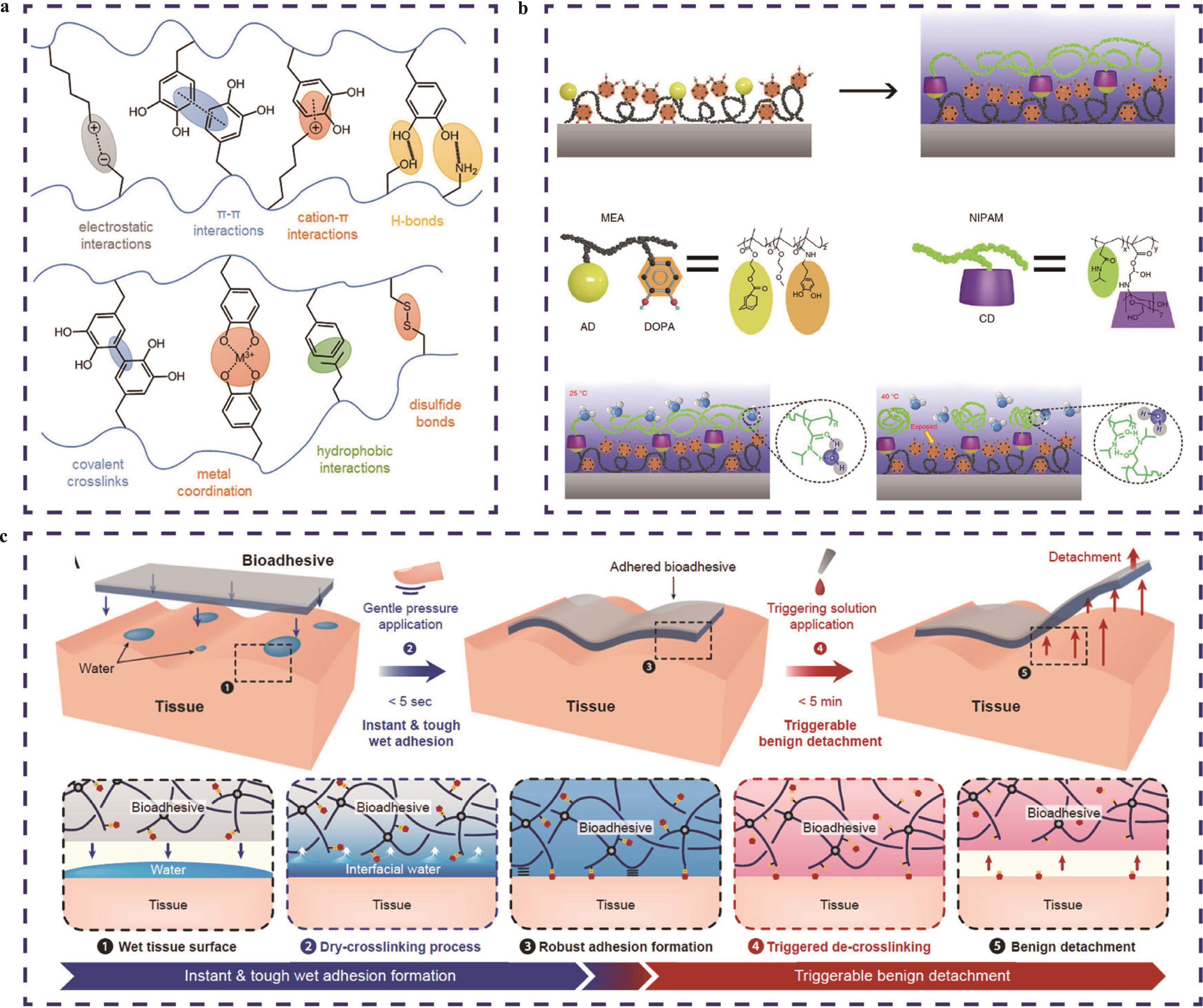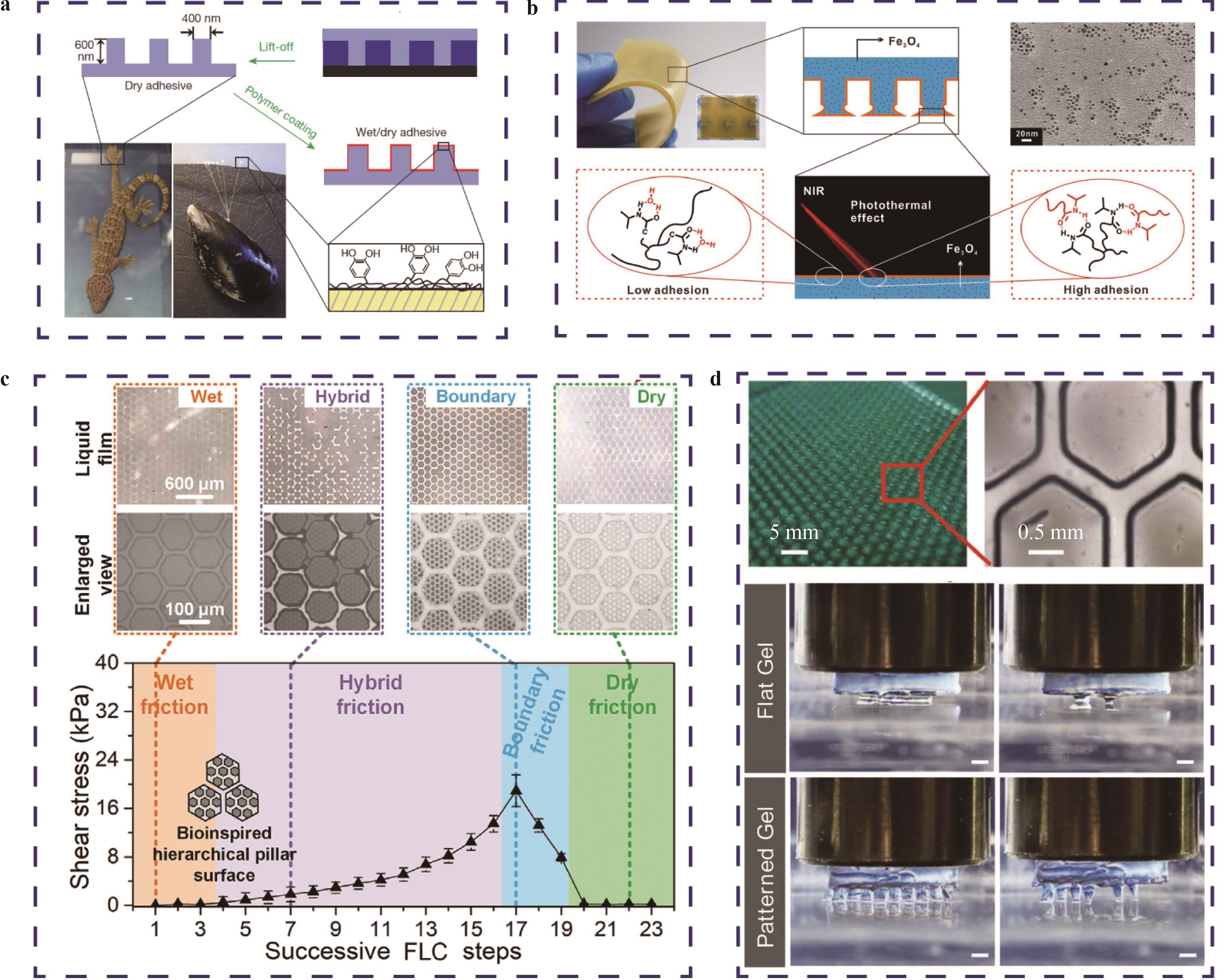
Chinese Journal of Applied Chemistry ›› 2022, Vol. 39 ›› Issue (1): 86-98.DOI: 10.19894/j.issn.1000-0518.210478
• Review • Previous Articles Next Articles
Recent Progress of Biomimetic Dry/Wet Friction Adhesion Devices
ZHANG Yun-Lei1,2,ZHAO Wei-Yi1,2,MA Shuan-Hong1( ),ZHOU Feng1(
),ZHOU Feng1( )
)
- 1.State Key Laboratory of Solid Lubrication,Lanzhou Institute of Chemical Physics,Chinese Academy of Sciences,Lanzhou 730000,China
2.Center of Materials Science and Opto-Electronics Engineering,University of Chinese Academy of Sciences,Beijing 100049,China
-
Received:2021-09-26Accepted:2021-10-28Published:2022-01-01Online:2022-01-10 -
Contact:Shuan-Hong MA,Feng ZHOU -
About author:mashuanhong@licp.cas.cn; zhouf@licp.cas.cn
-
Supported by:the Key Research Program of the Chinese Academy of Sciences(XDPB24);the National Natural Science Foundation of China(22032006);the Youth Innovation Promotion Association(2019411)
CLC Number:
Cite this article
ZHANG Yun-Lei, ZHAO Wei-Yi, MA Shuan-Hong, ZHOU Feng. Recent Progress of Biomimetic Dry/Wet Friction Adhesion Devices[J]. Chinese Journal of Applied Chemistry, 2022, 39(1): 86-98.
share this article
Add to citation manager EndNote|Ris|BibTeX
URL: http://yyhx.ciac.jl.cn/EN/10.19894/j.issn.1000-0518.210478

Fig.1 (a - d) A gecko and the hydrophobic multistage fractal structures on its toes[3,5]; (e - h) A tree frog and the hydrophilic hexagonal structures on its feet pads[12]; (i - j) A octopus and the suckers on its tentacles[14,21]; (k - m) Mussel and its byssus protein[22]

Fig.2 (a) A gecko and tree frog inspired gradient modulus structured device for friction and adhesion; (b - d) The preparation process and morphology of gradient modulus structured PDMS[33]; (e - g) Optical photographs and morphology of structured surface of the snakeskin-inspired dry friction device[37]; (h) Stimulus responsive structured polyurethane adhesive. (i) Reversible adhesion behavior of adhesive devices[38]

Fig.3 (a) Dopamine-based surface and interface interactions[18]; (b) Reversible adhesion strategy based on host-guest interactions and thermal responsive properties[19]; (c) Reversible adhesion strategy based on interface water absorption and dynamic bonding[53]

Fig.4 (a) Attachment and peeling states of the gecko toes inspired self-peeling shape memory polymer devices[58];(b) The grasping and releasing demonstration of the liquid crystal based device[60];(c) The grasping and releasing demonstration of the self-healing pressure driven grasping device based on Diels-Alder reaction[61]

Fig.5 (a) A reversible adhesion device realized by the combining effect of surface microstructure and mechanical deformation[62]; (b) A droplet transfer device realized by coupling the surface microstructure and asymmetric substrate curvature[65]; (c) Locomotion of smart soft robot achieved by coupling the surface microstructure and mechanical deformation of body[67]

Fig.6 (a) An underwater reversible adhesion strategy based on surface microstructure and enhanced by surface chemistry[40]; (b) An underwater reversible adhesion strategy achieved by Near-infrared (NIR) regulation of interface wettability[42]; (c) A friction strengthen strategy achieved by the capillary force generated from water film rupture between microstructural contact interfaces[70]; (d) Structured adhesion hydrogel devices[76]
| 1 | CHEN Y, MENG J, GU Z, et al. Bioinspired multiscale wet adhesive surfaces: structures and controlled adhesion[J]. Adv Funct Mater, 2020, 30(5): 1905287. |
| 2 | ARZT E, QUAN H, MCMEEKING R M, et al. Functional surface microstructures inspired by nature-from adhesion and wetting principles to sustainable new devices[J]. Prog Mater Sci, 2021: 100823. |
| 3 | AUTUMN K, LIANG Y A, HSIEH S T, et al. Adhesive force of a single gecko foot-hair[J]. Nature, 2000, 405(6787): 681-685. |
| 4 | AUTUMN K, SITTI M, LIANG Y C A, et al. Evidence for van der Waals adhesion in gecko setae[J]. PNAS, 2002, 99(19): 12252-12256. |
| 5 | HUBER G, MANTZ H, SPOLENAK R, et al. Evidence for capillarity contributions to gecko adhesion from single spatula nanomechanical measurements[J]. PNAS, 2005, 102(45): 16293-16296. |
| 6 | SONG Y, WANG Z, LI Y, et al. Electrostatic attraction caused by triboelectrification in climbing geckos[J]. Friction, 2020: 1-10. |
| 7 | IZADI H, STEWART K M, PENLIDIS A. Role of contact electrification and electrostatic interactions in gecko adhesion[J]. J R Soc Interface, 2014, 11(98): 20140371. |
| 8 | SINGLA S, JAIN D, ZOLTOWSKI C M, et al. Direct evidence of acid-base interactions in gecko adhesion[J]. Sci Adv, 2021, 7(21): eabd9410. |
| 9 | TIAN Y, PESIKA N, ZENG H, et al. Adhesion and friction in gecko toe attachment and detachment[J]. PNAS, 2006, 103(51): 19320-19325. |
| 10 | HANNA G, JON W, BARNES W J. Adhesion and detachment of the toe pads of tree frogs[J]. J Exp Biol, 1991, 155(1): 103-125. |
| 11 | BARNES W J P. Functional morphology and design constraints of smooth adhesive pads[J]. MRS bulletin, 2007, 32(6): 479-485. |
| 12 | SCHOLZ I, BARNES W J P, SMITH J M, et al. Ultrastructure and physical properties of an adhesive surface, the toe pad epithelium of the tree frog, Litoria caerulea white[J]. J Exp Biol, 2009, 212(2): 155-162. |
| 13 | HANNA G, BARNES W J P. Adhesion and detachment of the toe pads of tree frogs[J]. J Exp Biol, 1991, 155: 103-125. |
| 14 | TRAMACERE F, APPEL E, MAZZOLAI B, et al. Hairy suckers: the surface microstructure and its possible functional significance in the Octopus vulgaris sucker[J]. Beilstein J Nanotechnol, 2014, 5(1): 561-565. |
| 15 | GRECO G, BOSIA F, TRAMACERE F, et al. The role of hairs in the adhesion of octopus suckers: a hierarchical peeling approach[J]. Bioinspiration Biomimetics, 2020, 15(3): 035006. |
| 16 | SAREH S, ALTHOEFER K, LI M, et al. Anchoring like octopus: biologically inspired soft artificial sucker[J]. J R Soc Interface, 2017, 14(135): 20170395. |
| 17 | LI X, TAO D, LU H, et al. Recent developments in gecko-inspired dry adhesive surfaces from fabrication to application[J]. Surf Topogr: Metrol Prop, 2019, 7(2): 023001. |
| 18 | HOFMAN A H, VAN HEES I A, YANG J, et al. Bioinspired underwater adhesives by using the supramolecular toolbox[J]. Adv Mater, 2018, 30(19): 1704640. |
| 19 | ZHAO Y, WU Y, WANG L, et al. Bio-inspired reversible underwater adhesive[J]. Nat Commun, 2017, 8(1): 1-8. |
| 20 | SHINTAKE J, CACUCCIOLO V, FLOREANO D, et al. Soft robotic grippers[J]. Adv Mater, 2018, 30(29): 1707035. |
| 21 | BAIK S, PARK Y, LEE T J, et al. A wet-tolerant adhesive patch inspired by protuberances in suction cups of octopi[J]. Nature, 2017, 546(7658): 396-400. |
| 22 | WAITE J H. Mussel adhesion-essential footwork[J]. J Exp Biol, 2017, 220(4): 517-530. |
| 23 | ARZT E, GORB S, SPOLENAK R. From micro to nano contacts in biological attachment devices[J]. PNAS, 2003, 100(19): 10603-10606. |
| 24 | XIANG T, HOU J, XIE H, et al. Biomimetic micro/nano structures for biomedical applications[J]. Nano Today, 2020, 35: 100980. |
| 25 | HENSEL R, MOH K, ARZT E. Engineering micropatterned dry adhesives: from contact theory to handling applications[J]. Adv Funct Mater, 2018, 28(28): 1800865. |
| 26 | HU H, TIAN H, LI X, et al. Biomimetic mushroom-shaped microfibers for dry adhesives by electrically induced polymer deformation[J]. ACS Appl Mater Interfaces, 2014, 6(16): 14167-14173. |
| 27 | FISCHER S C, GROß K, TORRENTS ABAD O, et al. Funnel-shaped microstructures for strong reversible adhesion[J]. Adv Mater Interfaces, 2017, 4(20): 1700292. |
| 28 | YI H, KANG M, KWAK M K, et al. Simple and reliable fabrication of bioinspired mushroom-shaped micropillars with precisely controlled tip geometries[J]. ACS Appl Mater Interfaces, 2016, 8(34): 22671-22678. |
| 29 | ZHANG X, CHEN G, YU Y, et al. Bioinspired adhesive and antibacterial microneedles for versatile transdermal drug delivery[J]. Research, 2020, 2020: 3672120. |
| 30 | WANG Y, TIAN H, SHAO J, et al. Switchable dry adhesion with step-like micropillars and controllable interfacial contact[J]. ACS Appl Mater Interfaces, 2016, 8(15): 10029-10037. |
| 31 | JIN K, CREMALDI J C, ERICKSON J S, et al. Biomimetic bidirectional switchable adhesive inspired by the gecko[J]. Adv Funct Mater, 2014, 24(5): 574-579. |
| 32 | TAO D, GAO X, LU H, et al. Controllable anisotropic dry adhesion in vacuum: gecko inspired wedged surface fabricated with ultraprecision diamond cutting[J]. Adv Funct Mater, 2017, 27(22): 1606576. |
| 33 | LIU Q, TAN D, MENG F, et al. Adhesion enhancement of micropillar array by combining the adhesive design from gecko and tree frog[J]. Small, 2020: 2005493. |
| 34 | WANG Z. Slanted functional gradient micropillars for optimal bioinspired dry adhesion[J]. ACS Nano, 2018, 12(2): 1273-1284. |
| 35 | HU H, TIAN H, SHAO J, et al. Discretely supported dry adhesive film inspired by biological bending behavior for enhanced performance on a rough surface[J]. ACS Appl Mater Interfaces, 2017, 9(8): 7752-7760. |
| 36 | RAUT H K, BAJI A, HARIRI H H, et al. Gecko-inspired dry adhesive based on micro-nanoscale hierarchical arrays for application in climbing devices[J]. ACS Appl Mater Interfaces, 2018, 10(1): 1288-1296. |
| 37 | WANG M, GHOSH S K, STAFFORD C M, et al. Snakeskin-inspired elastomers with extremely low coefficient of friction under dry conditions[J]. ACS Appl Mater Interfaces, 2020, 12(51): 57450-57460. |
| 38 | TAN D, WANG X, LIU Q, et al. Switchable adhesion of micropillar adhesive on rough surfaces[J]. Small, 2019, 15(50): 1904248. |
| 39 | HU S, LOPEZ S, NIEWIAROWSKI P H, et al. Dynamic self-cleaning in gecko setae via digital hyperextension[J]. J R Soc Interface, 2012, 9(76): 2781-2790. |
| 40 | LEE H, LEE B P, MESSERSMITH P B. A reversible wet/dry adhesive inspired by mussels and geckos[J]. Nature, 2007, 448(7151): 338-341. |
| 41 | CHEN B, SEIDEL S, HORI H, et al. Self-assembly of pillars modified with vapor deposited polymer coatings[J]. ACS Appl Mater Interfaces, 2011, 3(11): 4201-4205. |
| 42 | MA Y, MA S, WU Y, et al. Remote control over underwater dynamic attachment/detachment and locomotion[J]. Adv Mater, 2018, 30(30), 1801595. |
| 43 | ZHANG C, WU B, ZHOU Y, et al. Mussel-inspired hydrogels: from design principles to promising applications[J]. Chem Soc Rev, 2020, 49(11): 3605-3637. |
| 44 | FAN H, GONG J P. Bioinspired underwater adhesives[J]. Adv Mater, 2021: 2102983. |
| 45 | LAMPING S, OTREMBA T, RAVOO B J. Carbohydrate-responsive surface adhesion based on the dynamic covalent chemistry of phenylboronic acid-and catechol-containing polymer brushes[J]. Angew Chem Int Ed, 2018, 57(9): 2474-2478. |
| 46 | WANG Z, GUO L, XIAO H, et al. A reversible underwater glue based on photo-and thermo-responsive dynamic covalent bonds[J]. Mater Horiz, 2020, 7(1): 282-288. |
| 47 | YANG B, LIM C, HWANG D S, et al. Switch of surface adhesion to cohesion by dopa-Fe3+ complexation, in response to microenvironment at the mussel plaque/substrate interface[J]. Chem Mater, 2016, 28(21): 7982- 7989. |
| 48 | XIE T, DING J, HAN X, et al. Wound dressing change facilitated by spraying zinc ions[J]. Mater Horiz, 2020, 7(2): 605-614. |
| 49 | AHN Y, JANG Y, SELVAPALAM N, et al. Supramolecular velcro for reversible underwater adhesion[J]. Angew Chem Int Ed, 2013, 52(11): 3140-3144. |
| 50 | ZHAO Q, LEE D W, AHN B K, et al. Underwater contact adhesion and microarchitecture in polyelectrolyte complexes actuated by solvent exchange[J]. Nat Mater, 2016, 15(4): 407-412. |
| 51 | NARKAR A R, BARKER B, CLISCH M, et al. pH responsive and oxidation resistant wet adhesive based on reversible catechol-boronate complexation[J]. Chem Mater, 2016, 28(15): 5432-5439. |
| 52 | YUK H, VARELA C E, NABZDYK C S, et al. Dry double-sided tape for adhesion of wet tissues and devices[J]. Nature, 2019, 575(7781): 169-174. |
| 53 | CHEN X, YUK H, WU J, et al. Instant tough bioadhesive with triggerable benign detachment[J]. PNAS, 2020, 117(27): 15497-15503. |
| 54 | MIN H, JANG S, KIM D W, et al. Highly air/water-permeable hierarchical mesh architectures for stretchable underwater electronic skin patches[J]. ACS Appl Mater Interfaces, 2020, 12(12): 14425-14432. |
| 55 | BAKER L B, MODEL J B, BARNES K A, et al. Skin-interfaced microfluidic system with personalized sweating rate and sweat chloride analytics for sports science applications[J]. Sci Adv, 2020, 6(50): eabe3929. |
| 56 | WU Y, PEI X, WANG X, et al. Biomimicking lubrication superior to fish skin using responsive hydrogels[J]. NPG Asia Mater, 2014, 6(10): e136-e136. |
| 57 | RONG M, LIU H, SCARAGGI M, et al. High lubricity meets load capacity: cartilage mimicking bilayer structure by brushing up stiff hydrogels from subsurface[J]. Adv Funct Mater, 2020, 30(39): 2004062. |
| 58 | XIE T, XIAO X. Self-peeling reversible dry adhesive system[J]. Chem Mater, 2008, 20(9): 2866-2868. |
| 59 | ZHANG Y, MA S, LI B, et al. Gecko’s feet-inspired self-peeling switchable dry/wet adhesive[J]. Chem Mater, 2021, 33(8): 2785-2795. |
| 60 | SHAHSAVAN H, SALILI S M, JáKLI A, et al. Thermally active liquid crystal network gripper mimicking the self-peeling of gecko toe pads[J]. Adv Mater, 2017, 29(3): 1604021. |
| 61 | TERRYN S, BRANCART J, LEFEBER D, et al. Self-healing soft pneumatic robots[J]. Sci Robot, 2017, 2(9): 1-12. |
| 62 | KIZILKAN E, STRUEBEN J, STAUBITZ A, et al. Bioinspired photocontrollable microstructured transport device[J]. Sci Robot, 2017, 2(2), eaak9454. |
| 63 | KIZILKAN E, GORB S N. Combined effect of the microstructure and underlying surface curvature on the performance of biomimetic adhesives[J]. Adv Mater, 2018, 30(19): 1704696. |
| 64 | TIAN H, LIU H, SHAO J, et al. An electrically active gecko-effect soft gripper under a low voltage by mimicking gecko's adhesive structures and toe muscles[J]. Soft Matter, 2020, 16(24): 5599-5608. |
| 65 | LIIMATAINEN V, DROTLEF D M, SON D, et al. Liquid-superrepellent bioinspired fibrillar adhesives[J]. Adv Mater, 2020, 32(19):2000497. |
| 66 | BAIK S, HWANG G W, JANG S, et al. Bioinspired microsphere-embedded adhesive architectures for an electrothermally actuating transport device of dry/wet pliable surfaces[J]. ACS Appl Mater Interfaces, 2021, 13(5): 6930-6940. |
| 67 | WANG X, YANG B, TAN D, et al. Bioinspired footed soft robot with unidirectional all-terrain mobility[J]. Mater Today, 2020, 35: 42-49. |
| 68 | LI Q, LI L, SHI K, et al. Reversible structure engineering of bioinspired anisotropic surface for droplet recognition and transportation[J]. Adv Sci, 2020: 2001650. |
| 69 | MA L, GAISINSKAYA-KIPNIS A, KAMPF N, et al. Origins of hydration lubrication[J]. Nat Commun, 2015, 6(1): 1-6. |
| 70 | ZHANG L, CHEN H, GUO Y, et al. Micro⁃nano hierarchical structure enhanced strong wet friction surface inspired by tree frogs[J]. Adv Sci, 2020: 2001125. |
| 71 | PENG Y, SERFASS C M, KAWAZOE A, et al. Elastohydrodynamic friction of robotic and human fingers on soft micropatterned substrates[J]. Nat Mater, 2021: 1-5. |
| 72 | YUK H, ZHANG T, PARADA G A, et al. Skin-inspired hydrogel-elastomer hybrids with robust interfaces and functional microstructures[J]. Nat Commun, 2016, 7(1): 1-11. |
| 73 | YU Y, YUK H, PARADA G A, et al. Multifunctional “hydrogel skins” on diverse polymers with arbitrary shapes[J]. Adv Mater, 2019, 31(7): 1807101. |
| 74 | BAIK S, KIM J, LEE H J, et al. Highly adaptable and biocompatible octopus-like adhesive patches with meniscus-controlled unfoldable 3D microtips for underwater surface and hairy skin[J]. Adv Sci, 2018, 5(8): 1800100. |
| 75 | KIM D W, BAIK S, MIN H, et al. Highly permeable skin patch with conductive hierarchical architectures inspired by amphibians and octopi for omnidirectionally enhanced wet adhesion[J]. Adv Funct Mater, 2019, 29(13): 1807614. |
| 76 | RAO P, SUN T L, CHEN L, et al. Tough hydrogels with fast, strong, and reversible underwater adhesion based on a multiscale design[J]. Adv Mater, 2018, 30(32): 1801884. |
| 77 | YI H, LEE S H, SEONG M, et al. Bioinspired reversible hydrogel adhesives for wet and underwater surfaces[J]. J Mater Chem B, 2018, 6(48): 8064-8070. |
| 78 | LIU H, ZHAO X, ZHANG Y, et al. Cartilage mimics adaptive lubrication[J]. ACS Appl Mater Interfaces, 2020, 12(45): 51114-51121. |
| [1] | Chen-Li HAO, Qing-Wei DING, Shi-Chang JIA, Yang-Bo MAO, Song-Bai WANG, Jun MA. Adsorption of Methylene Blue on Titanate Nanotubes Modified with Lipoic Acid [J]. Chinese Journal of Applied Chemistry, 2023, 40(5): 749-757. |
| [2] | Bo XIONG, Tai-Hua LI, Wu-Ping ZHOU, Chang-Yu LIU, Xiao-Long XU. Preparation of Cu2O/CuO-g-C3N4 Adsorbent by One-step Thermal Polymerization and Adsorption Properties for Methyl Orange [J]. Chinese Journal of Applied Chemistry, 2023, 40(3): 420-429. |
| [3] | Qian YANG, Yang ZHANG, Ming-Yang LAI, Lin GUO, Jian-Bo JIA. Adsorption Performance of Rhodamine B on Magnetic Biochar Prepared at Different Pyrolysis Temperatures [J]. Chinese Journal of Applied Chemistry, 2023, 40(2): 288-298. |
| [4] | Jian-Shuang ZHANG, Mei-Zhen GAO, Meng-Yao WANG, Qi SHI, Jin-Xiang DONG. Zeolitic Imidazolate Framework ZIF‑71 for Adsorption and Separation of 2,3‑Butanediol/1,3‑Propanediol From Dilute Aqueous Solutions [J]. Chinese Journal of Applied Chemistry, 2022, 39(11): 1735-1745. |
| [5] | Yue-Hua ZHAO, Da-Peng WANG. Coadsorption Kinetics of Amino‑Functionalized Graphene Oxide and Fatty Acids at the Water/Oil Interface [J]. Chinese Journal of Applied Chemistry, 2022, 39(8): 1274-1284. |
| [6] | Ying LI, Yun ZHANG, Liang-Liang LIN, Hu-Jun XU. Synergistic Effect of Ternary Compound System of Sodium N‑Lauroyl Methylalanine [J]. Chinese Journal of Applied Chemistry, 2022, 39(8): 1262-1273. |
| [7] | FAN Yue, TIAN Xue-Lin . Liquid⁃like Dynamic Interfacial Materials: Recent Progress on Their Applications [J]. Chinese Journal of Applied Chemistry, 2022, 39(1): 131-141. |
| [8] | ZHANG Wen-Jing, WANG De-Hui, DENG Xu . Research Progress on Condensation⁃Induced Invalid of Super⁃hydrophobicity [J]. Chinese Journal of Applied Chemistry, 2022, 39(1): 142-153. |
| [9] | ZHOU Hui, GUO Zhi-Guang. Recent Developments of Biomimetic Superwetting Materials for High Efficiency Water Collection [J]. Chinese Journal of Applied Chemistry, 2022, 39(1): 154-176. |
| [10] | ZHANG Jin-Hong, SHI Kui, XU Peng, LI Qian, XUE Long-Jian. Regulation of Friction Force of a Water Droplet on Bioinspired Surface [J]. Chinese Journal of Applied Chemistry, 2022, 39(1): 188-195. |
| [11] | YANG Wei-Guang, CAO Yu-Peng, JU Hong-Bin, WANG Ya-Kui, GENG Tao, JIANG Ya-Jie. Synthesis and Properties of Oleamide Quaternary Ammonium Gemini Surfactant [J]. Chinese Journal of Applied Chemistry, 2021, 38(2): 220-227. |
| [12] | TIAN Long, DOU Wei-Xin, YANG Wei-Ting, WANG Cheng. Size Effect of ZIF-8 on the Adsorption of Uranium [J]. Chinese Journal of Applied Chemistry, 2021, 38(1): 0-0. |
| [13] | TIAN Long, DOU Wei-Xin, YANG Wei-Ting, WANG Cheng. Size Effect of ZIF-8 on the Adsorption of Uranium [J]. Chinese Journal of Applied Chemistry, 2021, 38(1): 84-91. |
| [14] | WANG Yichen, LUO Jing, LIU Ren, DAI Shenghua. Progress in Preparation of Graphene Hollow Microspheres [J]. Chinese Journal of Applied Chemistry, 2020, 37(12): 1374-1383. |
| [15] | WEN Junjie,ZHOU Li ,WANG Ziwei,WEN Caihong,LIU Bo. Microwave Synthesis and Characterization of O-Hydroxypropyl-N-octyl Chitosan [J]. Chinese Journal of Applied Chemistry, 2015, 32(2): 192-199. |
| Viewed | ||||||
|
Full text |
|
|||||
|
Abstract |
|
|||||